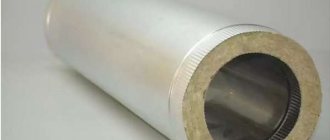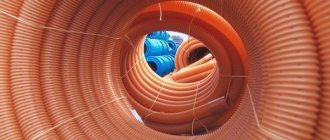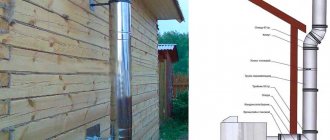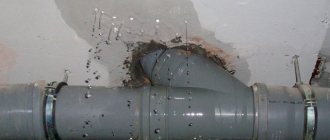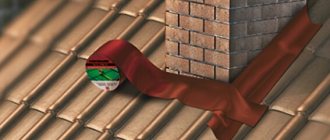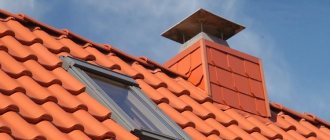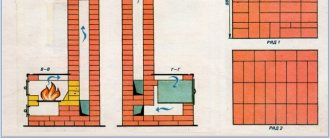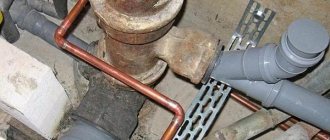PND - decoding or what it is
The abbreviation HDPE stands for simply: low-density polyethylene (you can find HDPE - it means the same thing as HDPE). The material is highly dense and is the end product of the polymerization reaction of polyethylene at low pressures. It is gray-transparent, hard, and is used as a raw material for the production of pipes for various purposes. These properties are explained by the special structure of the substance, the intermolecular bonds of which provide a higher density in comparison with other polyethylene analogues. It is also called high-density polyethylene (HDPE).
Installation of HDPE pipes
HDPE pipe products are more airtight than metal ones, their installation costs 5-7 times less and the connection is easier to make, since plastic melts easily.
Methods for installing low pressure polyethylene pipes:
- Bell-shaped detachable – used, as a rule, when installing sewerage systems. The pipes are equipped with special extensions at the end (sockets) and installation is carried out using seals. One pipe is inserted into the socket of the other, thereby ensuring a sealed joint.
- Fitting - used in systems operating under minimal pressure. It is a clamp fitting; a pipe is inserted into it. Using a tightening force, the elements are fastened together. A more reliable connection than a socket connection, although it also belongs to a detachable type.
- Electric welding is a connection of maximum strength; special fittings are welded to the pipe using a welding machine. Provides the greatest strength needed in pressure systems. It is carried out using a welding machine.
We recommend that you read: How to correctly bend a polypropylene pipe at home and avoid deformation
HDPE for cable
Technical HDPE cable pipe reliably protects communications, optical and power cables from possible damage.
Is different:
- smoothness of the inner surface;
- flexibility;
- strength;
- long service life;
- budget cost.
The products are not subject to high structural loads, since their main function is to protect cables from damage.
Thanks to low-density polyethylene - HDPE, as a material for production, the price of pipes is reduced as much as possible. This factor does not affect the quality of the parts. The corrugation for laying cables has been functioning efficiently and effectively for 50 years or more.
Using modern technologies, manufacturers provide:
- stable profile geometry along the entire length of the pipe;
- uniform density and wall thickness.
Polyethylene elements are an excellent solution for a small or large project.
Other analogues, the production of which is carried out using other materials, cannot be closely compared with the price of a smooth HDPE cable pipe.
Technical characteristics of HDPE pipes
HDPE pipes are produced in Russia in accordance with the quality standards specified in GOST 18599-2001. Products for plumbing are designed for laying pipelines and water and gas supply systems.
HDPE technical pipes – sewer. They are used as an element of drainage systems, as protective boxes and cable channels.
Durable polyethylene lasts a long time and is considered environmentally friendly because it does not emit toxic substances.
Advantages of the material; it is profitable to buy HDPE pipe for several reasons:
- long period of operation - up to 40 years;
- resistance to rust and chemical influences;
- no need to use additional protection when placed in the ground;
- polyethylene pipes are much cheaper than metal ones;
- fairly low heat transfer;
- scale and silt do not accumulate on the smooth walls of HDPE pipes throughout the entire period of operation;
- almost complete absence of condensation outside;
- the risk of rupture when moisture freezes in the pipe is eliminated, in which its diameter can increase by 5-7%, and after the liquid thaws, it can be reduced to its original value;
- ease of transportation and installation due to the lightness of polypropylene pipes - their weight is 6 times less than the weight of metal ones;
- simplicity, speed, reliability and more affordable cost of welding, maintaining the integrity of the connections throughout the entire period of operation of the pipes;
- the absence of toxic compounds in the composition, which explains the use of HDPE pipes in water supply systems in Europe, where compliance with environmental standards is monitored especially carefully.
Disadvantages of the material:
- installation work requires a non-standard approach;
- the presence of temperature restrictions that reduce the range of use of HDPE pipes;
- the service life is shorter than that of steel and cast iron analogues, determined by the mobility of the soil;
- sensitivity to ultraviolet radiation, which may reduce performance.
HDPE pipe prices
The cost of polyethylene pipes is undoubtedly favorable. Since polyethylene is a cheap raw material, products made from it cannot be too expensive. But this fact does not affect the quality.
That's why HDPE pipes are so in demand. The combination of affordable cost and current technical characteristics explains the use of such pipes as water, gas, and sewer pipes.
They are also used for wiring engineering systems inside buildings. They are used to lay cables underground.
HDPE 100 pipes (sdr 11, 13.6, 17, 17.6, 21 and 26) are based on the PE 80 series, which is relevant for gas pipelines, have improved properties, last longer, withstand higher pressures, and are resistant to mechanical stress.
Such products have a maximum strength limit of 1000 hours of operation with internal tension.
That is, the HDPE pipe will not crack when the water in it freezes. PE 80 pipes are cheaper than PE 100 pipes, since medium pressure polyethylene is used in their production.
Characteristics, GOSTs and certificates
HDPE pipes have the following technical characteristics:
- can function for at least 50 years;
- do not require further maintenance;
- are not subject to corrosive processes, they are not affected by the presence of fungus, bacteria, or other parasites;
- resistant to chemicals;
- characterized by low material density, which makes the pipeline elements very light;
- very easy to connect into a single highway;
- have low thermal conductivity;
- operate reliably at temperatures 0⁰С - 40⁰С;
- do not delay the flow of working media, since the inner surface is smooth.
If we take into account their elasticity, impact resistance, and low price, then you will not find better pipes for laying a main line.
The production of HDPE technical pipes is constantly evolving as technologies and equipment are regularly improved.
Today, the assortment is regulated by GOST 18599 2001, which defines the requirements for PE pipe parts for laying utility water mains. The technical documentation contains information on the production of technical HDPE pipes with specific characteristics and properties.
The mains mounted from such risers can move not only liquids, but also gases. The temperature of the transported media should not be higher than 40⁰С at low pressure not exceeding 25 atm.
Manufacturing companies engaged in the production of technical HDPE pipes have certificates of product compliance with existing regulatory documentation.
HDPE pipes in winter - installation, operation, important nuances
Anyone who chooses polyethylene pipes for the first time has a question: in what temperature ranges can they be used. After all, it is known that at low temperatures polymers become brittle, and at high temperatures they soften. Some sources increase concerns by indicating the operating range of HDPE pipes from 0° to + 40° C.
However, below zero, polyethylene pipes do not lose strength, and extensive operating experience, including in Russian frosts, shows that HDPE pipes are quite suitable for winter. In some aspects they are even preferable to steel ones. But the flexibility of polyethylene is still reduced, so the installation and operation of water supply has its own characteristics.
Materials and purpose
Recycled raw materials, polyethylene waste - material for the production of non-pressure polyethylene technical pipes HDPE (low pressure polyethylene). The main thing is that the polyethylene is light-stabilized. Otherwise, pipeline elements will be subject to negative light influence, which will reduce the service life of the pipeline.
The products are the best option for installing underground and hidden cable ducts. A smooth technical HDPE pipe is a riser-shell that will protect power wires, telephone lines, and other communication and electrical cables from mechanical stress, the influence of precipitation, and dirt.
The risers are easy to lay, they are not susceptible to destruction during long-term operation.
You can also familiarize yourself with the main types of PVC pipes and accessories for them.
The products have found their application in the installation of non-pressure water systems:
- drainage;
- reclamation canals;
- sewers;
- storm drain
HDPE pipe elements are indispensable for laying sewers, for water pipes to country houses and dachas.
Agriculture, construction, and chemical industries of the national economy cannot do without PE elements. With their help, heating mains are well insulated.
The low density of the material makes it possible to pack risers of small diameters into coils. Therefore, with this form of storage it is quite convenient to move polyethylene technical pipes.
Corrugated HDPE technical pipe has excellent insulating properties.
Like most pipe products, technical non-pressure HDPE pipes are connected:
- welding;
- polyethylene fittings (couplings, bends, tees, shut-off valves;
- compression fittings.
Product advantages
Like any manufactured product, this product has certain features that must be taken into account when selecting and installing equipment. To do this, you should familiarize yourself with its basic properties.
The characteristics of HDPE pipes consist of both positive and negative properties.
Firstly, the material from which it is made is not susceptible to the negative effects of corrosion processes. Thanks to this, you do not need to worry about additional insulation of HDPE pipes when laying underground or installing in a hidden way (inside a wall, or a specially equipped adit, for example).
In addition, you can use pipes made of low-density polyethylene to transport and supply water without fear for its quality (whereas in the case of cast iron and steel analogues, rust and a metallic taste of water may enter the water supply).
HDPE pipes are used for laying pipelines transporting drinking water, since polyethylene does not impair its quality
Secondly, polyethylene (PE) pipes are quite lightweight (as for plumbing equipment), so transporting them is not such a difficult and expensive process. It is also made easier by the fact that they are compactly packaged in special bays at the factory.
Note! Another positive characteristic of HDPE pipes is their long service life. The warranty period reaches 50 years. The reason is the same resistance to the development of corrosion processes.
The beneficial properties of HDPE pipes include the fact that they are not afraid of moisture, aggressive organic and chemical compounds. In addition, they do not react with oily and fatty substances.
Classification (Table) – Dependence of pressure on linear parameters
There are 2 main features of the classification of HDPE risers:
- By purpose.
- According to the degree of load bearing.
The first group includes products produced at low pressures, which are distinguished by a wide range of colors.
There are risers for:
- water pipes: color – absolutely blue or black with blue longitudinal stripes. Used for both cold and hot water supply;
- gas pipelines: shade – yellow or black with the presence of longitudinal yellowish or orange stripes;
- sewer structures are usually gray. With their help, external and internal systems are installed, as well as collectors are equipped. It is possible to manufacture it with sockets, which is very convenient for joining, since fittings are not needed;
- drainage systems. With their help, you can drain groundwater from areas under lawns, houses, and other structures. Corrugated products are used;
- wells They are used as casing structures that are not afraid of possible ground shifts;
- irrigation systems. The parts are an excellent option for arranging systems for supplying water to plants during the growing season.
Today, HDPE risers are also used for electrical installation work. Smooth or corrugated hoses are used in the installation of electrical, telephone and fiber optic lines. They can be used for trench or trenchless cable laying methods.
The second group of risers is represented by the following analogues:
- non-pressure. The elements are not subject to certain requirements regarding permissible loads of a technical nature;
- low-pressure. Can operate at a maximum pressure of about 600,000 Pa (6 atmospheres);
- high-pressure. They have walls up to 68-70 mm thick and can withstand pressures of about 1,800,000 – 2,000,000 Pa (18-20 atmospheres).
Today, sales markets are filled with products made from PE 100. This polyethylene is characterized by increased strength, high density (0.954 g/cm³) and can be used for 65-75 years at temperatures from -60℃ to +130℃. Thanks to these and many other properties, PE 100 is gradually replacing PE 80.
Dependence of pressure on linear parameters
| HDPE 100 | The magnitude of possible pressures, kPa | ||||||
| External diameter, mm | 600 | 850 | 950 | 1000 | 1250 | 1600 | 2000 |
| Wall thickness, mm | |||||||
| 16,00 | — | — | — | — | — | — | 2,00 |
| 20,00 | — | — | — | — | — | 2,00 | 2,30 |
| 25,00 | 2,00 | 2,30 | 2,80 | ||||
| 32,00 | — | — | — | 2,00 | 2,40 | 3,00 | 3,60 |
| 40,00 | — | 2,00 | — | 2,40 | 3,00 | 3,70 | 4,50 |
| 63,00 | 2,50 | 3,00 | 3,60 | 3.80 | 4,70 | 5,8 | 7,10 |
| 90,00 | 3,50 | 4,30 | 5,20 | 5,40 | 6,7 | 8,20 | 10,10 |
| 125,00 | 4,80 | 6,00 | 7,10 | 7,40 | 9,20 | 11,40 | 14,00 |
| 160,00 | 6,20 | 7,70 | 9,10 | 9,50 | 11,80 | 14,60 | 17,90 |
| 200,00 | 7,70 | 9,60 | 11,40 | 11,90 | 14,70 | 18,20 | 22,40 |
| 225,00 | 8,60 | 10,80 | 12,80 | 13,40 | 16,60 | 20,50 | 25,20 |
| 250,00 | 9,60 | 11,90 | 14,20 | 14,80 | 18,40 | 22,70 | 27,90 |
HDPE pipes for pumps and wells
As can be seen from the above, HDPE pipes are very widespread and have many areas of application. Separately, it is necessary to say about those products that are used for the pump, as well as about casing materials.
Until recently, only metal-plastic pipes that were mounted on fittings were suitable for a submersible pump. However, today it is possible to lay a highway using high-density HDPE products. Among them, both pressure and non-pressure are distinguished. The latter are used as drainage or sewerage. The former are used in all water supply systems.
HDPE pipes for wells
Casing pipe is used for casing artesian wells. The casing allows you to strengthen the walls of the well, arrange a water supply for the dacha, carry out directional drilling, and so on.
The casing for the dacha is quite strong, which allows it to be driven into the ground. Strength is achieved due to the materials used and the manufacturing method, the essence of which is HDPE extrusion.
Such products can be threaded or go without it. Depending on this, either a fitting connection or a threaded connection is made.
The casing for a summer residence with and without thread has the following characteristics:
- The diameter ranges from 90 to 180 mm. There are also products of large diameter;
- The wall thickness ranges from 7.3 mm to 14;
- With thread (in the vast majority of cases) or without it (extremely rarely);
- The length is 4 m, but there are sections of larger sizes, for example, up to 12 meters.
It must be said that when making a well for a summer residence, a casing string made of HDPE can be used, as well as a water supply line from HDPE and a separate element for protecting the electrical wiring.
It should also be noted that, as a rule, casing elements have thicker walls, that is, they are more durable. Since such a change entails an increase in cost, it is simply not practical to use them as drainage channels or wiring protection channels. On the contrary, in very loose soils, that is, where the lateral pressure is much less than, for example, in clay soils, conventional large-diameter products are used as casing.
Casing HDPE pipes
Conclusion: As can be seen from all of the above, using HDPE materials, various systems can be assembled: cold water supply for a dacha, protection of the electrical wiring of pumping stations or simply in the attic of a dacha, drainage, and sewerage. That is, we can safely talk about the versatility of such products. And this is not the only advantage - low weight, high strength, long service life and, of course, reasonable price. All this makes low-density polyethylene and elements made from it such a necessary type of plastic, like no other type.
Popular diameters (Table)
When purchasing HDPE pipes, you need to be guided by the outer diameters and wall thickness. These parameters determine the scope of application of the products.
Risers with a cross-section from 16 to 63 mm are indispensable when laying electrical cables in buildings and in the ground.
Parts with a diameter of 50-75 mm are suitable for arranging waste systems for bathtubs, washing machines, and sinks. Cables from lamp posts and wires along roads are placed in them.
Almost most of us have dealt with pipes with a diameter of 110 mm, since they are used for sewer lines. Electrical and fiber optic structures are placed in such pipe elements.
Among the risers of large diameters, parts with a cross section of 400, 800, 1000, 1200, 1600 mm stand out. The construction of storm and sewer collectors, pressure water pipelines, drainage mains is the scope of application of such risers.
It is often necessary to know how much an HDPE pipe weighs. This is due to the fact that it is necessary to calculate in advance the mass of the suspended sewer system and the structure for laying electrical communications.
The table shows how much 1 meter of HDPE pipe weighs, depending on the outer diameter and SDR value.
Calculated weights of popular polyethylene pipes made of PE-63, PE-80, PE-100
| HDPE 100 | The magnitude of possible pressures, kPa | ||||||
| External diameter, mm | 600 | 850 | 950 | 1000 | 1250 | 1600 | 2000 |
| Wall thickness, mm | |||||||
| 16,00 | — | — | — | — | — | — | 2,00 |
| 20,00 | — | — | — | — | — | 2,00 | 2,30 |
| 25,00 | 2,00 | 2,30 | 2,80 | ||||
| 32,00 | — | — | — | 2,00 | 2,40 | 3,00 | 3,60 |
| 40,00 | — | 2,00 | — | 2,40 | 3,00 | 3,70 | 4,50 |
| 63,00 | 2,50 | 3,00 | 3,60 | 3.80 | 4,70 | 5,8 | 7,10 |
| 90,00 | 3,50 | 4,30 | 5,20 | 5,40 | 6,7 | 8,20 | 10,10 |
| 125,00 | 4,80 | 6,00 | 7,10 | 7,40 | 9,20 | 11,40 | 14,00 |
| 160,00 | 6,20 | 7,70 | 9,10 | 9,50 | 11,80 | 14,60 | 17,90 |
| 200,00 | 7,70 | 9,60 | 11,40 | 11,90 | 14,70 | 18,20 | 22,40 |
| 225,00 | 8,60 | 10,80 | 12,80 | 13,40 | 16,60 | 20,50 | 25,20 |
| 250,00 | 9,60 | 11,90 | 14,20 | 14,80 | 18,40 | 22,70 | 27,90 |
How to connect pipes made of technical polyethylene. Video
In addition to welding, they use 3 more methods of joining HDPE risers:
1. Electrofusion.
2. Flanged.
3. Fitting.
Application of electric couplings
Electric couplings are used in cases of limited space, which eliminates the possibility of welding.
The essence of the method is that the connecting surface is melted using a heating element.
The connection procedure is performed as follows:
- place the parts on the same axis;
- clean the edges of the products from dirt and dust, degrease the joints, remove (clean) the surface layer of the connecting parts;
- Place the electrofusion coupling on the surface and connect it to an electrical source.
The properties of polyethylene pipes are such that after heating, the edges slightly melt around the entire perimeter and, under the influence of the required pressure, a reliable hermetic connection is obtained.
Each master independently determines the time of supply of electricity, since it is visually visible when it is necessary to join the molten edges.
Flange connection
Flanges can be slip-on or have welded bushings, the installation algorithm of which is as follows:
- trim the sections of the risers at the junction as much as possible; put the bushing on the end and weld it;
- attach the flange using the thread;
- carry out the same installation using the second flange using a bolted connection.
Using fittings
The fitting method of connection is also called joining using a compression coupling.
This technical operation is used in cases of pairing:
- risers of the same diameters;
- various sections;
- pipes made of different materials (plastic with metal, polyethylene with metal-plastic).
Advantages of the method:
- application without special devices and equipment;
- low price of connecting parts.
Algorithm for performing the work:
- unscrew the union nut 3-4 turns;
- remove the chamfer from the end of the riser, clean it of dirt;
- mark on the pipe the maximum distance that the fitting can fit;
- place the coupling at the level of the mark;
- tighten the union nut.
Thanks to the O-rings, which are fixed with press-fit bushings, the joint is completely sealed.
Popular diameters
Using corrugations with an outer diameter of 25, 32 mm, distribution boxes are connected to switchboards, and the boxes are also connected to each other.
Interfloor lines of cable products are installed in HDPE technical pipes of 40 and 50 mm.
Corrugated products of different diameters have different purposes. For laying telephone communications and alarm systems, a corrugation with a diameter of 16 mm is sufficient. This cross-section is suitable for connecting cables to lighting fixtures. Technical HDPE pipe 20 mm is an excellent option for a supply hose to a socket or switch.
The original pipes are HDPE sdr 17 with a cross section of 75 mm. For their production, primary and secondary raw materials are used. Products of this kind - with a smooth internal and external surface - are used for laying underground pipelines. Products are available in black or dark gray shades; options with visible inclusions are possible.
PE technical risers-shells with diameters from 16 to 100 mm are folded into coils. The length of coils with a section of 40, 63, 75 mm is 100 meters. PE risers with a cross-section of 90-110 mm are transported in 50- or 100-meter bays. Products with large diameters: 160, 200, 225, 250, 400 mm can only be straight sections 6 m or 12 m long.
The scope of application of non-pressure technical parts depends on the diameter.
Products are available in different diameters in the range of 20 – 400 mm. This parameter determines the throughput, that is, the number of electrical cables that can pass inside, as well as the flexible properties of the riser. For example, products 110 – 160 mm are an ideal option for installing wires under roads.
All products of the above diameters are also used for installing sewer systems. In this case we are talking about external diameters.
Depending on the wall thickness, products can be:
- light, medium-light;
- medium, lightly medium;
- heavy, medium-heavy.
The weight of the parts directly depends on the wall thickness, which can range from 2 mm to 9.5 mm and above. Technical HDPE pipes are sold both wholesale and retail. The price of products depends on wall thickness, diameter, manufacturer, and other factors.
HDPE pipe production technology
Technologically, the polymerization process is as follows:
- Ethylene polymerizes, after which the molten substance is sent to the extruder.
- The extruder squeezes the polymer mass through a special mold, after which the product becomes like a pipe.
- Next comes the rolling mill, where the product takes on its final shape and is marked.
- Finished HDPE pipes are packaged in coils of 100, 200, and in special cases 1000 m long. In some cases, you can find products 12 meters long.
The essence of the technology is the polymerization of molecules of organic gas ethylene in a low-pressure environment. As a result of polymerization, a dense, plastic polymer, polyethylene, is formed, from which pipes are made.
Polymerization methods
There are several technologies for ethylene polymerization:
- Suspension. Various industrial chemicals and even clay are used as stabilizers. The composition is constantly mixed, thanks to this each monomer is polymerized better, the particles of the material grow together as tightly as possible. The method has one drawback - the remains of the chemical stabilizer end up in the polymer structure.
- Solution is a HDPE production process in which a catalyst is used and the process is affected by low temperatures (60-120 degrees Celsius). The resulting polymer is homogeneous, flexible, capable of self-healing after minor changes in the original forms, and is resistant to abrasion. The procedure is complicated by the selection of a catalyst; it is necessary to select the components with high quality so that, under the influence of temperature, they minimally enter into a parallel chemical reaction, affecting the final result.
- Gas-phase is an outdated technology, the main disadvantage of which is the low quality of the final product. The gas environment is the technological basis of the method. Crosslinking of molecules (connection) occurs as a result of diffusion activity. Molecules move freely and collide, thus forming a structural lattice in a somewhat chaotic manner. The uneven structure of the material produced using gas-phase technology affects the homogeneity of the polymer, worsening its wear resistance properties.
- There is also an alternative technology for recycling polyethylene, recycling polymer that has served its life. Economically, less production costs are required. Polymers are not created anew, they are given a second life, so the financial investment is relatively small. Environmentally, working with recyclable materials causes minimal harm to the environment, and also effectively solves the issue of storage after the end of its service life.
We recommend that you read: The main manufacturers on the HDPE pipe market in Russia
